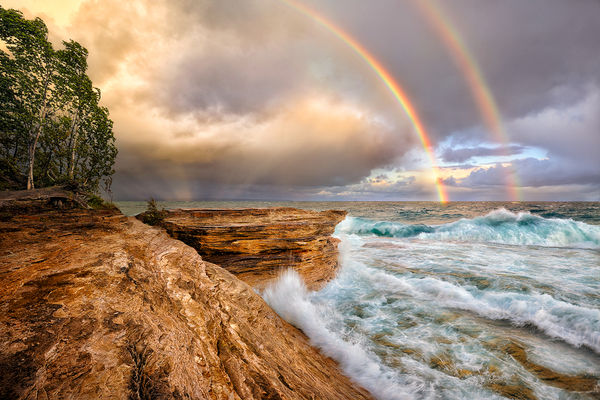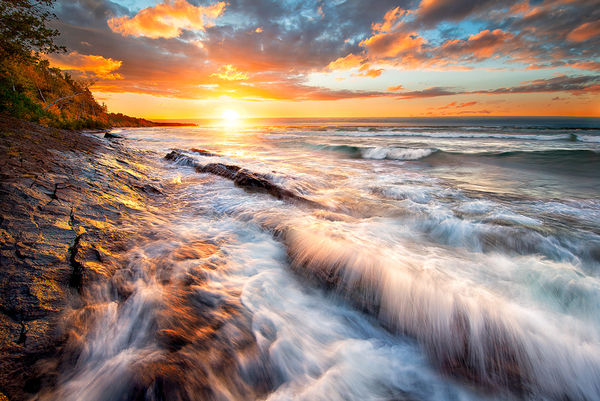Back Button Focus vs. cable release
Feb 5, 2016 20:29:03 #
big-guy wrote:
Not sure what your getting at here. You set the ca... (show quote)
Ah so.....I knew I was making the issue bigger than it is! BBF locks the focus and there is NO rush. Thanks.
Feb 5, 2016 20:31:32 #
orrie smith wrote:
obtain focus with the back button focus, then release the camera and use the cable release to capture the photo. the bbf is just to get the picture in focus, and unlike the shutter button, it may be released and still maintain focus.
Yes! Got it!
Feb 5, 2016 20:34:15 #
Thank you all for your input. As always, you get honest, specfic and to-the-point responses on this forum. I appreciate that very much.
Feb 5, 2016 23:37:05 #
rbfanman wrote:
Who needs a cable release? Get a remote release (electronic), or set the timer for 10 seconds, and hit the shutter release. The ten seconds between hitting the shutter, and the shot, will let the vibrations caused by touching the shutter release die down. BBF, and leave that be. Turn AF off if need be.
I use a cable release instead of a timed release so I can time elements in the shot.
For example, I shoot a lot up along the shore of L. Superior. A cable release allows me to time me shot for the perfect wave - can't do that with a 10 second timer.
Another use is for combating wind in a scene. You can lock up your mirror and just wait till it stops (or slows down) for a second and then snap the shutter before it starts again.
So, timer release works good sometimes, but there are times a cable release can be your best friend.
The two shots below are good examples of when using a cable release to catch the perfect wave paid off:
Feb 6, 2016 05:43:36 #
Nice photos! They look like HDR photos, which may have issues with motion in the scene because they take 3 or more exposures while the scene changes. I guess this could be responsible for the water effect, which looks similar to what happens when you use a slow shutter speed on moving water? Did you use multiple exposures with the waves in different positions? I did notice on one of my HDR's the moving clouds produced like after images which I think is called a ghosting effect or double image (and yet the moving water in the harbor in the same photo had very sharply focused ripples)), but with water moving fast enough so the each frame shows some of the "smoke" or blurring effect, which is then combined by Photomatix or whatever HDR software you use? I am confused too by what I just said, but I think you may understand what I am getting at. Unless it was all done from a single shot in the first place and not multiple exposures.
Steve Perry wrote:
I use a cable release instead of a timed release s... (show quote)
Feb 6, 2016 05:47:18 #
MtnMan wrote:
I usually use timed release instead of the cable with my D800 on tripod. (The reason is the stupid design of the cable attachment). I don't use bbf but you might see if the 2 sec delay works for you.
But for landscape I've mostly gone to Bryan Peterson's suggestion to not focus at all. I turn autofocus off and set the lens on infinity.
But for landscape I've mostly gone to Bryan Peterson's suggestion to not focus at all. I turn autofocus off and set the lens on infinity.
MtnMan, I often see a photog say what you just said about setting the lens on infinity. Can you please explain to me how you do this, and how it gets you the sharp focus you want?
Feb 6, 2016 06:59:03 #
MtnMan wrote:
Don't know about the 750.
Yes, it has a connection point.
Feb 6, 2016 07:03:26 #
Szalajj
Loc: Salem, NH
rbfanman wrote:
Who needs a cable release? Get a remote release (electronic), or set the timer for 10 seconds, and hit the shutter release. The ten seconds between hitting the shutter, and the shot, will let the vibrations caused by touching the shutter release die down. BBF, and leave that be. Turn AF off if need be.
Unfortunately, I was only able to get a cable release for my Canon Rebel T5, at least from my favorite local camera dealer. In most cases, it has worked well for me, only occasionally giving me problems with not being able to focus on a subject. When this happens, I switch to manual focus, refocus, and snap away.
Feb 6, 2016 07:48:04 #
OHenry wrote:
I've seen the light about BBF and I've been practi... (show quote)
When I use a cable release I manually focus using LV set 2 sec delay on the shutter and use the cable release
Feb 6, 2016 07:59:23 #
MtnMan wrote:
I usually use timed release instead of the cable with my D800 on tripod. (The reason is the stupid design of the cable attachment). I don't use bbf but you might see if the 2 sec delay works for you.
But for landscape I've mostly gone to Bryan Peterson's suggestion to not focus at all. I turn autofocus off and set the lens on infinity.
But for landscape I've mostly gone to Bryan Peterson's suggestion to not focus at all. I turn autofocus off and set the lens on infinity.
Not every lens has a hard stop for infinity so how do you do this? Do you use live view or the VF? Please explain and thanks.
Feb 6, 2016 09:10:50 #
Mark7829
Loc: Calfornia
Dngallagher wrote:
Obviously, BBF has its place, BUT not for everythi... (show quote)
You really don't need IR or a cable release for long exposures. Just use the self timer on the camera and set it to shoot 2 seconds after shutter release. Keep using BBF.
Then again, check your manual for various settings on BBF. I have a D810 with various settings for BBF and setting for the shutter release. You might see if there is a setting to the shutter not to focus/re-focus.
Feb 6, 2016 09:31:56 #
georgevedwards wrote:
Nice photos! They look like HDR photos, which may ... (show quote)
Thanks - nope, these are not shot as HDRs. I do manual blending in photoshop using layer masks and luminosity masks as needed. That way, I can pick and choose what parts of each image end up in the photo and what doesn't (no ghosting that way). In the rainbow image, it was just a single exposure double-processed in LR (one for highlights, the other for normal / shadow areas).
The sunset one was a two shot blend, one for the sky and one for the water / land.
The waves are pretty much a result of the shutter speed used - I don't think I blended for waves in the rainbow photo, but I believe I did a slight bit of blending in waves form two different shots in the sunset. If I recall, the main image had the nice break over the foreground but I think I blended in a wave from another shot (taken the same time / place of course) for the one of the background waves. But the foreground was all one image - it was just messy :)
Feb 6, 2016 09:48:35 #
jradose wrote:
MtnMan, I often see a photog say what you just said about setting the lens on infinity. Can you please explain to me how you do this, and how it gets you the sharp focus you want?
First, turn off autofocus. You can do this with the switch on the lens and/or through the menu.
Then look at the lens. You will see a little plastic window with numbers and the infinity sign near the focus ring. Align the middle of the infinity sign (8 on it's side) with the marker by turning the focus ring.
You need to be a little careful with some lenses (e.g. My Sigma 17-50) because if you manually turn the focus ring with autofocus on you could do damage. Not a problem with most Nikon lenses: you can turn the focus ring any time.
Note this works best with wide angle lenses at high f-stop because DOF is huge so insensitive to actual focus distance setting.
Feb 6, 2016 10:25:20 #
For maximum DOF I highly recommend setting the lens at the hyperfocal distance for landscapes. No auto or manual visual focusing required and the results are the next best thing to focus stacking as far as I'm concerned.
Feb 6, 2016 10:28:10 #
Thanks for the info! Those shots look incredible, they have a lot of the postive effects of the HDR's without that pesky "edge glow" which I don't like. I have been doing some luminosity masks so I have an idea of what you are talking about there, the ability to target narrow tonal ranges that are sort of lost in the original, whicy is what HDR does in a different way, or maybe even similar to a kind "tonal equalizer", in music where there are a series of sliders that target more narrow ranges of tone rather than just bass and treble. However I admit "layer masks" are something whose use and meaning has still eluded me, despite several attempts to get a handle on them. Do have a few words in a nutshell about what they do?
Steve Perry wrote:
Thanks - nope, these are not shot as HDRs. I do ma... (show quote)
If you want to reply, then register here. Registration is free and your account is created instantly, so you can post right away.









